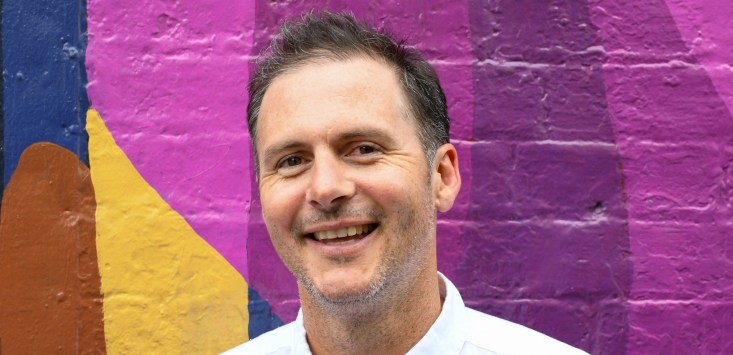
Bluethumb co-founder Ed Hartley. Source: Supplied
Australia’s visual arts sector and entrepreneurial bible Atomic Habits seem to have little overlap.
But speak with Bluethumb co-founder Ed Hartley, and you’ll hear how one of the book’s key lessons is exemplified by successful visual artists — and how the online art marketplace has learned a thing or two, too.
Bluethumb was founded in 2012 by brothers Ed and George Hartley, who have turned the Adelaide-born enterprise into a platform boasting 370,000 original artworks from around 20,000 artists.
Some 400,000 people now visit the Bluethumb site each month.
More than a decade after its launch, Bluethumb is expanding into the US and marketing itself not just as an art marketplace, but as a data-rich digital innovator.
“What separates Bluethumb from everyone else is that we’re creating a technology company, and we’ve always invested in tech,” Ed Hartley recently told SmartCompany.
“And that’s the reason we sell a lot more art than anyone else.”
After proving that Australians will buy art sight unseen, without setting foot in a physical gallery, Bluethumb is using the data it collects to steer buyers through its dizzying array of artists, styles, and compositions.
“You can sit on your couch in your PJs and buy art, but the thing that gets a little bit daunting is the quantity of art,” Hartley said.
“So then it’s up to us to make sure that user experience is excellent so people can find what they want.”

Source: Supplied
Creatures of habit
The other side of Bluethumb’s data analysis is what it provides to artists, who can use those insights to finetune their practices to meet the needs of the average art buyer.
This is where James Clear’s bestseller Atomic Habits comes into play.
Consider Tania Chanter, who Bluethumb says has sold 780 works since 2018 for a combined total of nearly $1 million in earnings.
Chanter recently moved to add one new artwork to the Bluethumb catalogue each day.
Bluethumb also states artist Ben Tankard recently departed his day job to pursue visual art full-time and has cracked 500 sales on the platform.
Discussing how artists can benefit from rapid production and feedback, Hartley referenced a famous experiment referenced in Atomic Habits.
The book tells the story of American photography professor Jerry Uelsmann, who split his class into two groups: one tasked with producing as many photos as possible, and the other with producing the best photos.
Students in the first group were graded on the quantity of images produced; the latter group would be graded on quality.
To his surprise, Uelsmann found the former group actually produced the best photos, with the professor chalking this up to the benefits of mass experimentation.
“It’s basically because of the repetition, the experimentation and the learning, the velocity of work,” Hartley said.
“And that’s how we approach things at Bluethumb.
“It’s the velocity of growth, and trials, and tests, and data that flows through, in my belief, to art.
“So the more you practice, the more you work, the more you paint, the more hours you put in, the better you get, and the faster you improve.”
For some artists, this can lead to higher prices, greater sales, and a viable career in the field.
“If you actually work really hard, and have your distribution channels like Bluethumb set up, you can make a living, and a really good living, in your profession,” he said.
“And while you’re doing that, you get better and better”.
Lessons for business
In art, and in any entrepreneurial pursuit, there is no guarantee that trying and trying again will result in revelation.
Still, Hartley suggests the Atomic Habits experiment has lessons for his own venture.
Bluethumb has launched into the US market, and Hartley says the lessons learned over its 12-year Australian history put it in good stead overseas.
But Hartley is under no misconceptions about how difficult it will be to crack a market with established players like Artsy, Singulart, and even good old Etsy.
“You cannot build a marketplace overnight,” he said.
“You can’t just deploy money at it and instantly grow.
“You need to actually go through the process and the hard work.”
The enterprise is currently looking at its US expansion as a decade-long project.
“In ten years, who knows, it could be bigger than Bluethumb Australia given the market size,” Hartley said, giving it enough time to rapidly experiment and learn, Atomic Habits-style.
Handpicked for you

$63 billion online spend: Australian basket sizes shrink but purchase frequency up



COMMENTS
SmartCompany is committed to hosting lively discussions. Help us keep the conversation useful, interesting and welcoming. We aim to publish comments quickly in the interest of promoting robust conversation, but we’re a small team and we deploy filters to protect against legal risk. Occasionally your comment may be held up while it is being reviewed, but we’re working as fast as we can to keep the conversation rolling.
The SmartCompany comment section is members-only content. Please subscribe to leave a comment.
The SmartCompany comment section is members-only content. Please login to leave a comment.